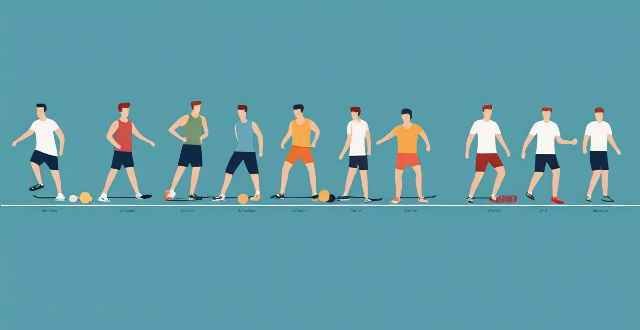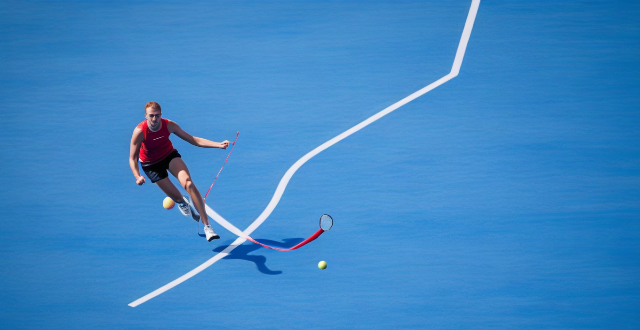Risk Sport

Can sport monitoring technology help prevent injuries ?
Sport monitoring technology has become increasingly popular in recent years, with many athletes and coaches using it to improve performance and prevent injuries. This technology includes wearable devices such as fitness trackers, heart rate monitors, and GPS tracking systems, as well as more advanced technologies like motion capture systems and force plates. Sport monitoring technology works by collecting data on an athlete's movements, heart rate, and other physiological factors. This data is then analyzed to provide insights into the athlete's performance and identify areas where they may be at risk of injury. By tracking an athlete's movements and physiological factors, sport monitoring technology can identify potential injury risk factors early on, help coaches create personalized training plans for each athlete based on their individual needs and abilities, monitor recovery periods between sessions, and educate athletes and coaches about injury prevention strategies. Overall, there is evidence to suggest that sport monitoring technology can help prevent injuries in several ways. However, it is important to note that no technology can completely eliminate the risk of injury, and proper training, conditioning, and safety measures should always be prioritized.

Is rock climbing still considered an extreme sport ?
Rock climbing has been traditionally viewed as an extreme sport due to its inherent risks and physical demands. However, with the evolution of safety equipment, increased accessibility, and a broader range of difficulty levels, the classification of rock climbing as an extreme sport is subject to debate. Factors contributing to its extreme nature include physical challenge, risk involvement, skill and experience, environmental conditions, psychological components, and technical aspects. On the other hand, factors that may diminish its extreme status are improved safety measures, accessibility and popularity, varying difficulty levels, professional guidance, community support, and competitive aspects. Therefore, whether rock climbing is still considered an extreme sport depends on individual perception and the specific context in which it is practiced.

Are there any risks or drawbacks associated with sport psychology counseling ?
Sport psychology counseling is a specialized form of psychological intervention that aims to enhance athletic performance, improve mental toughness, and foster personal growth in athletes. While the benefits of sport psychology counseling are well-documented, it is essential to consider any potential risks or drawbacks associated with this type of intervention. The risks and drawbacks include: - Lack of qualified professionals - Overreliance on counseling - Inappropriate interventions - Ethical considerations - Financial costs - Cultural differences To mitigate these risks, athletes should seek out qualified professionals with appropriate certifications and experience in sport psychology counseling, communicate openly with their counselor about their goals and concerns, choose counselors who prioritize ethical practices, explore options such as group sessions, online counseling, or sliding scale fees to reduce costs, and counselors should strive to understand and respect the cultural backgrounds of their clients and adapt their approaches accordingly. By addressing these issues proactively, athletes can maximize the benefits of sport psychology counseling while minimizing any potential negative effects.

Which extreme sport has the highest mortality rate ?
This article explores which extreme sport has the highest mortality rate. It discusses five extreme sports: parachuting, base jumping, free solo climbing, big wave surfing, and skydiving. Based on available data, base jumping appears to have the highest mortality rate among extreme sports, followed closely by free solo climbing. However, it is important to note that participating in any extreme sport requires proper training, equipment, and supervision to minimize the risks involved.

Can early specialization in a single sport hinder overall development in adolescents ?
This text discusses whether early specialization in sports can hinder the overall development of adolescents. It considers physical, psychological, and educational impacts, arguing that while early specialization may offer a path to athletic success, it can also lead to overuse injuries, psychological strain, limited social interaction, and neglect of education. The text advocates for participation in multiple sports during adolescence to promote more balanced and holistic development.

What is sport psychology counseling ?
Sport psychology counseling, a specialized area ofSport psychology counseling, a specialized area of mental and emotional aspects of athletic a specialized area of psychology, focuses on the mental and emotional aspects of athletic performance. It involves working with athletes and coaches to improve mental skills, enhance performance, and manage stress related to sports. Key areas include mental skills training, performance enhancement, stress management, team building, injury rehabilitation, and career transition. Benefits include improved performance, increased confidence, reduced anxiety, better teamwork, effective coping mechanisms, and personal growth. Sport psychology counseling is crucial for enhancing an athlete's mental well-being and physical performance.

What qualifications should a sport psychology counselor have ?
Sport psychology counselors, also known as sport psychologists or mental performance consultants, are professionals who work with athletes to improve their mental and emotional skills related to sports performance. To be an effective sport psychology counselor, one should possess the following qualifications: - Educational Background: A foundation in psychology, sports science, or a related field is essential. Many sport psychology counselors have a master's degree in counseling, psychology, or sports psychology. Some positions may require a doctoral degree (Ph.D. or Psy.D.) in psychology or a related field with a specialization in sport psychology. - Professional Training: Completion of specialized training programs in sport psychology offered by recognized organizations. Hands-on experience through internships or practical placements working with athletes or teams. - Licensure and Certification: Depending on the country, state/provincial licensure as a psychologist may be required to practice independently. Obtaining certification from reputable organizations such as the Association for Applied Sport Psychology (AASP) demonstrates expertise and commitment to the field. - Skills and Personal Attributes: Ability to effectively communicate with athletes, coaches, and other support staff. Proficiency in active listening to understand athletes' needs and concerns. The capacity to empathize with athletes and provide supportive guidance. Flexibility to work with diverse populations and adapt techniques to individual needs. Strict adherence to ethical standards, including maintaining confidentiality. - Continuing Education and Development: Ongoing education to stay current with research and advancements in sport psychology. Participation in workshops, conferences, and continuing education courses. - Ethical Standards and Professionalism: Adherence to a code of ethics set forth by professional organizations. Clear understanding and maintenance of professional boundaries with clients. - Interpersonal Relations: The ability to work collaboratively with coaches, trainers, and other support staff. Understanding and respect for diverse cultural backgrounds of athletes. - Assessment and Evaluation: Proficiency in using psychological assessments to evaluate athletes' mental states. Establishing feedback systems to measure progress and adjust interventions accordingly.

How does sport psychology counseling differ from traditional counseling ?
Sport psychology counseling and traditional counseling are two distinct fields that share some similarities but also have key differences. The primary focus of sport psychology counseling is on helping athletes improve their performance by addressing mental and emotional factors that affect their sports performance, while traditional counseling focuses on helping individuals deal with a wide range of personal and emotional issues. The approach used in sport psychology counseling includes techniques such as goal setting, visualization, relaxation techniques, and cognitive restructuring, while traditional counseling uses a variety of therapeutic approaches to help individuals deal with their emotional and psychological issues. The primary goal of sport psychology counseling is to help athletes improve their performance by addressing mental and emotional factors that affect their sports performance, while the primary goal of traditional counseling is to help individuals improve their overall well-being by addressing a wide range of personal and emotional issues. Sport psychology counseling is typically sought by athletes who want to improve their performance or overcome obstacles that are hindering their success, while traditional counseling is sought by individuals who are dealing with a wide range of personal and emotional issues.

How do sports movies impact the popularity of a particular sport ?
Sports movies can impact the popularity of a particular sport through storytelling, celebrity endorsement, increased visibility, and inspiration/motivation. These films can create an emotional connection between the audience and the sport, bring attention to it through famous actors/actresses, make it more visible to a wider audience, and inspire/motivate those already involved in the sport.

What are the benefits of seeking sport psychology counseling for athletes ?
Sport psychology counseling provides athletes with numerous benefits, including improved performance, stress management, mental toughness, enhanced team dynamics, and personal growth. Athletes can develop better focus, confidence, and goal-setting abilities, learn to manage anxiety and pressure, cope with adversity, and improve communication and leadership skills within their teams. Additionally, sport psychology counseling promotes self-awareness, life skills, and balance in an athlete's life. Seeking the help of a sport psychology professional can significantly contribute to an athlete's overall well-being and success in their sport.

How can sport psychology counseling help athletes improve their performance ?
Sport psychology counseling is a specialized field that focuses on the mental and emotional aspects of athletic performance. It aims to enhance an athlete's mindset, motivation, and overall well-being to improve their sporting outcomes. Here's how it can be beneficial: Goal Setting and Motivation: Sport psychologists help athletes set Specific, Measurable, Achievable, Relevant, and Time-bound goals. This clarity in objectives boosts motivation and directs efforts toward improvement. Confidence and Self-Esteem Building: Coaching athletes to replace negative self-talk with positive affirmations enhances their confidence and self-belief. Anxiety and Stress Management: Techniques like deep breathing, progressive muscle relaxation, and mindfulness can reduce anxiety levels before and during competitions. Focus and Concentration: Improving an athlete's ability to focus on relevant cues and block out distractions is crucial for peak performance. Team Dynamics and Interpersonal Skills: Enhancing communication within teams fosters better cooperation and understanding among athletes. Mental Toughness and Resilience: By preparing mentally for setbacks, athletes learn resilience and are better equipped to handle difficulties when they arise. Recovery and Balance: Adequate rest is essential for physical recovery and maintaining mental sharpness. Sport psychologists can guide effective strategies. Helping athletes achieve a balance between their sport and personal lives prevents burnout and keeps them motivated.

How does sport specialization at a young age impact overall development ?
Sport specialization at a young age can have both positive and negative impacts on a child's overall development. While it allows for skill development, confidence building, and potential opportunities for college scholarships and professional careers, it can also lead to overuse injuries, burnout, limited social interaction, physical development issues, psychological pressure, and narrow life experiences. Parents and coaches are advised to encourage variety in activities, monitor training intensity, promote balance, listen to children's feelings, and seek professional advice to ensure well-rounded development.

Can sport psychology counseling be beneficial for non-athletes as well ?
Sport psychology counseling can be beneficial for non-athletes as well. The techniques used in sport psychology, such as cognitive restructuring, relaxation training, and visualization, can help individuals manage stress, anxiety, and depression. Additionally, these techniques can enhance performance in various areas of life, develop better coping skills, and increase self-awareness. By applying the principles and techniques used in sport psychology to everyday life situations, individuals can improve their mental health, enhance their performance, develop better coping skills, and increase their self-awareness.

How do sports movies contribute to the overall popularity of a sport ?
How do sports movies contribute to the popularity of a sport? 1. Increased Awareness: Sports movies bring attention to the sport and its athletes, leading to more people participating in the sport. 2. Inspiration and Motivation: Inspiring stories of athletes overcoming obstacles can motivate viewers to pursue their own athletic goals or try a new sport. 3. Cultural Impact: Sports movies can shape public perceptions of certain sports and make them more socially acceptable or desirable. 4. Economic Benefits: Popular sports movies can generate interest in purchasing related merchandise, attending live events, or watching televised games, leading to higher revenues for teams, leagues, and sponsors involved in the sport. 5. Entertainment Value: Sports movies provide an enjoyable viewing experience that appeals to a wide audience, attracting new fans to the sport and helping maintain its popularity over time.

How does the type of sport influence the design of a sports stadium ?
The type of sport played in a stadium significantly influences its design, with each sport having unique requirements and considerations. The size and layout of the stadium must accommodate the specific dimensions needed for the sport, such as a larger soccer field compared to a basketball court. The seating capacity is also influenced by the popularity of the sport, with larger stadiums often required for sports with large fan bases. Facilities and amenities within the stadium are tailored to the sport, including specialized equipment or technology like scoreboards for sports that require them. Acoustics play a role in some sports, with quiet environments necessary for tennis matches and louder environments for football games. Safety and security measures are also tailored to the sport, with additional padding or barriers needed for contact sports and extra security measures for sports that attract rowdy fans. In conclusion, the design of a sports stadium is heavily influenced by the type of sport being played, requiring unique considerations for each sport's needs in terms of size, layout, facilities, acoustics, and safety.

How long does it typically take to see results from sport psychology counseling ?
Sport psychology counseling aims to improve athletic performance and mental skills. The timeline for seeing results varies based on factors like individual differences, goal specificity, commitment level, and support systems. Short-term results include increased awareness and improved focus within 1-3 months, mid-term results such as enhanced confidence and performance within 3-6 months, and long-term results like sustained success and deepened self-understanding after 6+ months of consistent counseling. Working with a qualified sport psychology professional and maintaining commitment can maximize potential for success in sports and life.

What role do international sports organizations play in promoting peace through sport ?
International sports organizations contribute significantly to promoting peace through various initiatives. These include building bridges and enhancing diplomatic relations by promoting diplomacy and cultural exchange, providing platforms for youth development through empowerment and creating opportunities, advocating for gender equality and inclusivity, contributing to humanitarian efforts like disaster relief and peace missions, and educating about peace and conflict resolution through awareness campaigns and partnerships with peace organizations.

Can watching sports-themed films inspire people to take up a new sport ?
**Yes, sports-themed films can inspire people to take up a new sport by fostering an emotional connection, showcasing the excitement and cultural significance of sports, providing learning opportunities, and highlighting the social benefits of team activities.**

In what ways can dance be considered both a sport and an art form ?
Dance is a unique form of expression that can be considered both a sport and an art form. As a sport, it requires physical strength, endurance, and coordination. As an art form, it involves creativity, emotion, and aesthetics. Dancers must have strong muscles to execute lifts, jumps, and other challenging movements. Dance performances often last for several hours, requiring dancers to maintain their energy and stamina throughout the show. Dancers must have excellent coordination to move their bodies in sync with music and other dancers on stage. Many dance styles require a high degree of flexibility. Dancers must adhere to strict training regimens to maintain their physical condition and technique.

How can sport psychology counseling help with mental health issues such as anxiety and depression in athletes ?
Sport psychology counseling is a valuable resource for athletes dealing with mental health issues such as anxiety and depression. It involves understanding the problem, setting goals, managing stress, building confidence, developing emotional intelligence, and fostering social support. Tailored approaches, consistency, and patience are key to achieving long-term success in improving both mental well-being and performance.

Is skydiving considered an extreme sport ?
Skydiving is considered an extreme sport due to its high level of risk and the physical and mental demands it places on participants.

What are the potential risks associated with children specializing in one sport too early ?
Specializing in a single sport at an early age can have both advantages and disadvantages for children. While it may lead to improved skill development and potential for higher-level competition, there are also several potential risks associated with this approach. These include physical risks such as overuse injuries, burnout, and lack of cross-training benefits; psychological risks like pressure and stress, narrowed social experiences, and fear of failure; developmental risks including delayed skill development, loss of childhood, and reduced adaptability; social risks such as isolation, peer pressure, and limited life skills; and academic risks such as time management challenges and prioritization issues. To mitigate these risks, experts often recommend encouraging diverse participation in sports until late adolescence, ensuring a balanced approach between sports, school, and leisure time, providing access to mental health resources for athletes dealing with stress and pressure, and involving parents in a supportive but not pushy way.

What services do sports rehabilitation centers offer ?
Sports rehabilitation centers offer a variety of services to help athletes recover from injuries and improve their overall performance. These services include physical therapy, athletic training, strength and conditioning programs, sport-specific training, and recovery strategies. Physical therapy involves manual therapy, therapeutic exercise, and functional training to regain strength, flexibility, and mobility in injured areas. Athletic trainers assess injuries, develop personalized rehabilitation plans, and implement prevention strategies to reduce the risk of future injuries. Strength and conditioning programs focus on building muscle strength, increasing endurance, and improving flexibility through resistance training, cardiovascular training, and stretching exercises. Sport-specific training involves developing skills and techniques required for success in a particular sport, as well as mental preparation for competition. Recovery strategies such as cryotherapy, massage therapy, and proper hydration and nutrition help athletes recover from intense training sessions or competitions more quickly and efficiently.

How dangerous is BMX biking compared to other extreme sports ?
BMX biking is an extreme sport that involves riding a bicycle on various terrains and performing stunts. While it can be thrilling and exciting, it also comes with certain risks such as head injuries, broken bones and fractures, and road accidents. Compared to other extreme sports like base jumping, rock climbing, and skydiving, BMX biking has its own unique set of dangers. To stay safe while enjoying the sport, it's important to wear proper safety gear, learn proper technique, choose safe locations, stay alert, and maintain your bike.

What benefits do sports-specific training programs offer ?
Sports-specific training programs offer several benefits, including improved performance, increased physical fitness, enhanced mental toughness, better recovery and injury prevention, and personalized coaching and support. These programs focus on developing the skills, techniques, and physical abilities required for success in a particular sport, helping athletes reach their full potential while also improving their overall health and well-being.

What is the risk involved in investing in bonds ?
Investing in bonds carries risks such as interest rate, credit, inflation, liquidity, reinvestment, call, prepayment, foreign currency, and political/regulatory changes. Understanding and managing these risks is crucial for protecting your investment. Diversifying your portfolio across different types of bonds and monitoring market conditions can help mitigate these risks.

What are the key components of a successful disaster risk management plan ?
Key Components of a Successful Disaster Risk Management Plan include: 1. Risk Assessment 2. Prevention and Mitigation Strategies 3. Preparedness Activities 4. Response Mechanisms 5. Recovery and Rehabilitation 6. Continuous Improvement

What challenges do filmmakers face when creating realistic sports action scenes ?
Creating realistic sports action scenes in films is a challenging task for filmmakers. They need to capture the essence of the sport while maintaining authenticity and excitement for viewers. The challenges they face include achieving accurate representation, capturing high-energy action, maintaining audience interest, enhancing visual effects, and adapting to different sports genres. By successfully overcoming these obstacles, filmmakers can deliver captivating sequences that capture the spirit of sports and leave audiences on the edge of their seats.

Why is it important to conduct a climate risk assessment ?
Climate risk assessment is crucial for understanding the potential impacts of climate change on different sectors and systems, identifying vulnerabilities and risks, developing adaptation strategies and policies, enhancing resilience and reducing losses, and supporting decision making. It helps in building a more resilient and sustainable future for all.

How can governments implement climate risk management policies to protect their citizens and infrastructure ?
Governments can implement climate risk management policies by assessing the risks, developing a comprehensive plan, investing in resilience and adaptation measures, engaging stakeholders and building public awareness, and monitoring and evaluating progress.